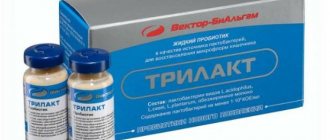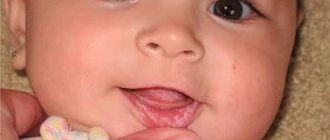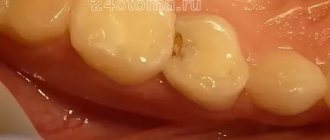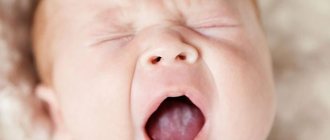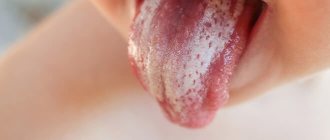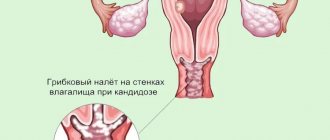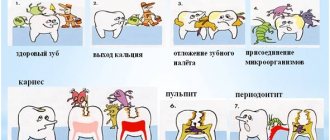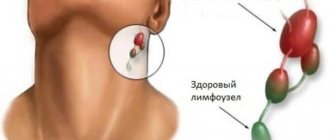Thrush or candidiasis is a well-known disease, the development of which occurs due to the activity of yeast fungi called “Candida”. These microorganisms are opportunistic, therefore they exist peacefully in the body of almost all inhabitants of the Earth.
However, a temporary drop in immunity or another unfavorable factor can cause activation of fungal microflora, triggering the development of corresponding ailments. One of these is the already summarized candidiasis. Read more about its course in infants, the danger of the pathology for their body and the principles of its treatment below.
What does thrush look like in a child?
Any part of the oropharynx can be affected: tongue, lips, corners of the mouth, gums, mucous membranes of the cheeks, palate, pharynx, tonsils. White grains (spot coating) appear, reminiscent of curdled milk, or a film (solid coating) of a cheesy appearance. These elements are easily removed by scraping with a spatula, revealing a bright red base, sometimes with a bleeding surface. As a rule, the course of the infection is painless and has only local manifestations. General health is not affected.
Causes of candidiasis
The main cause of candidiasis in children is a yeast fungus of the genus Candida, present in the human microflora. But to activate it and increase the number of microorganisms, a number of factors are required:
- weakened immune system;
- frequent viral and colds;
- thyroid diseases;
- diabetes;
- hypovitaminosis;
- taking hormonal drugs or antibiotics for a long time;
- chronic diseases;
- HIV infection;
- intestinal dysbiosis.
The disease often occurs in premature infants and weakened children. If the mother's birth canal has been affected by candida, the baby, passing through it, becomes infected. The risk of developing candidiasis in such a newborn is much higher.
How to treat thrush in a child?
The disease is treated at home. Local medications are used and only as prescribed by a doctor: pediatrician or dentist! Special antifungal agents are used in the form of solutions, sprays, gels, and drops. For maximum effectiveness of therapy, the drug must remain in the oral cavity (on the mucous membrane) for as long as possible. Therefore, the main way to use them is by rinsing or lubricating.
Treatment is long, up to 2-3 weeks.
It is important!
Often thrush in the mouth of infants is associated with candidiasis of the skin of the nipples and areola in the mother. In this case, the woman experiences redness, irritation, and a burning sensation on her chest. In this case, treatment should be comprehensive, for mother and baby.
General information
Candidiasis in children is a common disease among children. Normally, small amounts of fungi are part of the opportunistic microflora and are constantly present in the body. If the child’s immunity is strong, microorganisms are safe for health. In weakened children, the fungus begins to multiply uncontrollably, affecting the mucous membranes, skin, and genitals. If candidiasis is left untreated, serious health problems can follow. The main task of parents in the fight against the disease is to establish good nutrition and strengthen the child’s immunity.
Child nutrition
Simple carbohydrates are the main nutrient medium for fungal growth. Therefore, sweets, sugar, cookies, etc. must be excluded from the patient’s diet. Breastfeeding certainly continues.
If the child is bottle-fed or mixed-fed, then preference should be given to formulas containing probiotic microorganisms, which have the largest evidence base for their effectiveness. These are LGG and BB-12 from Chr. Hansen. It has been proven that LGG and BB-12 inhibit the growth of opportunistic microorganisms and fungi, protect against the development of caries and infections, and effectively prevent atopic eczema. Nutrilak Premium Comfort is enriched with LGG probiotic.
Symptoms of pathology
Candidiasis in infants
The development of thrush in newborns and very young children is more than pronounced. In general, the pathology occurs in three stages, at each of which specific symptoms are observed.
If we consider each stage of candidiasis in more detail, we should highlight:
- Absence of discomfort in a sick child at the first stage of the disease. It is indirectly indicated only by redness in the mouth, a slight cheesy coating on the tongue and the appearance of a sour odor from the baby’s mouth.
- A more pronounced manifestation of the noted symptoms in the second stage of the disease, also supplemented by the formation of small erosions in the oral cavity and pain in the child. The latter, by the way, are expressed in the constant crying of the baby, which cannot be calmed down.
- The most severe manifestation of pathology is at the last – third stage. Symptoms at this stage of thrush are the most pronounced and severe. It often manifests itself in damage to the entire oral cavity, which results in the appearance of large areas covered with a cheesy coating. Often additional signs of the disease are fever, abnormal bowel movements and insomnia in infants.
Perhaps the most obvious signs of candidiasis in a small child are:
- strong sour odor from the mouth;
- the appearance of a cheesy coating in the oral cavity;
- temperature rise to 38 degrees Celsius.
Having discovered at least one of the noted manifestations in their child, parents must show it to the pediatrician.
At a minimum, before starting treatment, it is important to confirm with a specialist the fact of thrush and receive basic recommendations for combating the pathology. It is better not to self-medicate candidiasis in infants, for example, due to its considerable danger.
Symptoms of thrush
The pathogenetic basis of the disease is the occurrence of a local inflammatory process at the site of fungal invasion.
They begin to actively reproduce with the release of waste products, which provokes an appropriate immune response from the child’s body. The clinical picture of thrush is characterized by the formation of a typical white plaque in the affected area. In the early stages of the disease, it is not always possible to immediately distinguish colonies of fungi from remains of food or milk. Parents sometimes ignore the problem, especially in the absence of other signs of the disease. To differentiate, it is enough to wipe the baby’s tongue or lips with a napkin or damp towel. Residues of food can be easily washed off. But fungal colonies are difficult to grow, so they remain. Common additional clinical symptoms:
- irritability of the child, frequent crying;
- deterioration of appetite up to complete refusal to eat. It all depends on the degree of damage to the oral mucosa by the fungus;
- disruption of normal sleep rhythm.
In advanced cases, when the fungus spreads to the underlying parts of the digestive tract - into the lumen of the esophagus, stomach and intestines, dyspeptic disorders (abdominal pain, nausea, regurgitation, diarrhea-type bowel dysfunction) are additionally associated. In case of damage to the external genitalia, a characteristic white coating is found in the area of the labia majora and minora (in girls) or the foreskin (in boys).
Possible deviations
All infectious diseases in children tend to quickly spread to other organs and systems. Girls, even in infancy, can develop vaginal candidiasis. Vulvovaginitis is dangerous because in girls, who at this age have extremely delicate mucous membranes, there may be fusion of the vagina or labia. This problem can only be solved surgically. That is why the mother should regularly check the condition of the child’s genitals: for redness and discharge. In addition, against the background of thrush, other, much more serious and dangerous conditions can often develop - generalization of the process and the development of sepsis (an infectious disease caused by the spread of bacterial or fungal flora from the source of infection into the blood, lymphatic tract, and from them into all tissues and organs). Therefore, a serious approach to prevention, early detection, effectiveness and timely treatment of thrush is necessary. The process may be complicated by the addition of a bacterial infection, spreading to the gastrointestinal tract.
With insufficient treatment, oral candidiasis can take a chronic, relapsing course. The child may begin to refuse to eat, sleep is disturbed, and the baby becomes irritable. Changes occur in the protective function of the child’s body, allergic reactions develop, and a predisposition to the development of various diseases, such as bronchial asthma, is formed.
Treatment of candidiasis
The goal of treatment for candidiasis in children is to eliminate symptoms and prevent further proliferation of fungi in order to reduce their number. General recommendations for strengthening the baby’s body are as follows:
- reduce the consumption of sweet, salty and flour foods, which create a favorable environment for the growth of candida;
- take vitamin complexes, including folic and ascorbic acids, probiotics to normalize microflora;
- give the child drugs to strengthen the immune system;
- For newborns on artificial nutrition, switch to medicinal mixtures containing probiotics and vitamins.
If candidiasis has affected the oral cavity, treatment of the mucous membrane with antifungal agents is prescribed:
- a solution of baking soda, fucorcin or brilliant green;
- Miramistin (antiseptic);
- Clotrimazole (antifungal ointment);
- Nizoral, Pimafucin (antimycotic medications);
- spray for sore throat, stomatitis.
It is recommended to lubricate nails infected with fungus with iodine, antifungal ointments Clotrimazole, Decamine, Mikoseptin and varnishes. If the vagina is affected in girls, antifungal suppositories are recommended. You should not select medications yourself. It is better to consult a doctor and get examined. Self-medication can only worsen the baby’s condition. If thrush, despite the measures taken, does not go away, you may need to consult an immunologist, because This condition is usually associated with weak immunity.
Prevention of candidiasis
To avoid thrush, follow the disease prevention measures:
- Mothers in labor are advised to sanitize the birth canal before giving birth. To do this, the woman takes a smear, based on the results of which the doctor determines the need for treatment. If candidiasis is diagnosed, vaginal suppositories with antiseptics are prescribed. This measure will prevent the baby from becoming infected with fungi.
- Follow the rules of hygiene in the maternity hospital.
- Breastfeed your baby only unless there are medical indications for bottle feeding. In the latter case, you need to choose the right mixture together with your pediatrician.
- Limit the consumption of sweets and sugar in children over one year of age. Try to keep your diet varied, healthy and nutritious.
- If the baby is weakened, strengthen the immune system with hardening procedures, proper nutrition, physical exercise, etc.
Candidiasis is an unpleasant but treatable disease. Timely consultation with a pediatrician, the correct course of therapy and compliance with preventive measures will allow you to forget about thrush for a long time. SM-Doctor specialists are always ready to help your child in the fight against candidiasis.
Diagnosis of candidiasis
A pediatrician usually has no problems diagnosing thrush on the oral mucosa.
This is a common disease with characteristic symptoms, so an experienced specialist can easily identify it. In particularly difficult cases, when diagnosing a sore throat, sputum analysis may be required to identify the pathogen. The situation is more complicated with the diagnosis of candidiasis on the genital mucosa. In this case, you will have to take a smear for microflora, which will show the presence of inflammation and help identify the causative pathogen.
Thrush on internal organs is even more difficult to detect: external symptoms may be absent. Blood, urine, and stool tests may be required to detect mycosis.

